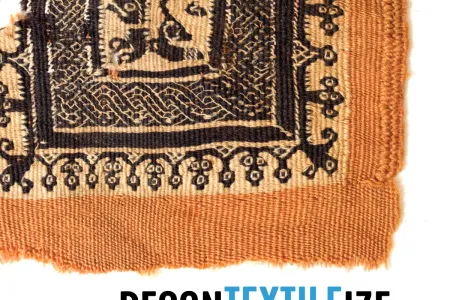
360°: Textiles in Context
This cluster provides a multidisciplinary approach to the technical analysis, historical interpretation, and museum display of early Byzantine textiles.
This cluster provides a multidisciplinary approach to the technical analysis, historical interpretation, and museum display of early Byzantine textiles.
This cluster provides a multidisciplinary approach to the technical analysis, historical interpretation, and museum display of early Byzantine textiles. Students will undertake technical analysis of materials and production techniques, and how to relate technical evidence to questions of early Byzantine textiles' function, social meaning, and public display in both the early medieval and contemporary periods. Students will be introduced to the shifting uses of these objects in life and death as well as the changing ways in which scholars have interpreted and displayed these objects over time. Equipped with this background, students will organize an original exhibition of early Byzantine textiles from the Jefferson University Collection and present their knowledge and interpretations at the College and to wider communities through the exhibition and through their contributions to the Jefferson University publicly accessible online collection catalog.
Courses
This course, co-taught by Marianne Weldon and Alicia Walker, introduces the science of textiles through hands-on training in the analysis of textile weaving techniques and materials. Students will learn to identify fibers, weave structures, dyes, and mordants through visual and instrumental analysis culminating in their ability to fully identify the methods of production of an authentic early Byzantine textile. Instrumentation used will include polarized light microscopy, high performance liquid chromotrography, and x-ray florescence spectroscopy.
This course explores the manifold uses and meanings of textiles in early Byzantine culture. Textiles are examined as indicators of social status and the expression of individual and group identity. Special attention is paid to the iconography of textile decoration and its relation to Byzantine cultural and religious traditions and values. The significance of textiles in local production as well as long distance trade in the early medieval era allows us to think about material culture in pre-modern "global" systems of trade. Textiles are also considered as a metaphor in Christian theology, and the connection between actual and ideal textiles is examined. The course explores the fraught history of the excavation, collections, sale, and display of textiles in the modern and contemporary eras. The status of textiles as a "minor" or "decorative" art in nineteenth- and twentieth-century scholarship is problematized in relationship to current art historical and archaeological methodologies that privilege the function and social values of material culture. The ethical questions surrounding the excavation and sale of textiles in the early twentieth century as well as changing practices of alteration and display are examined. Taught by Alicia Walker.

ReconTEXTILEize: Byzantine Textiles from Late Antiquity to the Present
The exhibition was hosted in Canaday Library (Coombe Suite and Lobby) and Park Science Center, from April 18 to June 2, 2019.
Previous Courses
When taught in 2018-2019, this cluster included an Exhibition course.
This course builds toward a student-curated exhibition of early Byzantine textiles. Students will investigate past exhibitions of textiles, including early Byzantine textiles, as case studies, reading catalogues and accounts of critical reception in order to understand different curatorial strategies and to apply what they learn in the curatorial organization of their own public exhibition. They will develop original documentation of objects for entry in Philadelphia University online, publicly accessible collection database. They will examine various pedagogical strategies for writing interpretive exhibition didactics and identifying audiences, before writing and developing their own didactics and programming. Collectively, they will determine a curatorial agenda, produce didactic materials, develop public programs, script tours for different audiences, and install an exhibition of approximately 20 early Byzantine textiles (mostly fragments). Co-taught by Alicia Walker and Carrie Robbins.